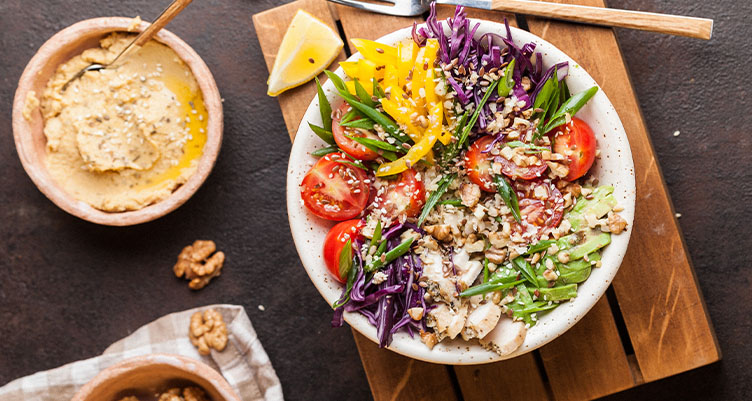What Is a Low Carb Diet? What You Need to Know for Weight Loss

- A low carb diet is a diet that restricts carbohydrates and focuses on healthy sources of proteins and fats.
- Benefits of a low carb include weight loss, improved blood sugar and increased energy.
- The best foods to eat on a low carb diet are complex carbs (including fiber).
Keto, paleo and the Atkins diet may get all the buzz when it comes to low carb, but people can’t forget about the OG: a low carb diet.
A low carb (carbohydrate) diet involves restricting the number of carbohydrates, such as pasta, white bread and sugary snacks. Instead of carbs, you’ll round out your plate with satisfying proteins and nourishing fats to promote fullness.
Keep reading to learn more about the low carb diet, including what you can eat (and what to avoid) and how to determine if it’s right for you.
Benefits of a Low Carb Diet
Make no mistake: following the low carb diet isn’t easy (prepare to dream of macaroni and cheese). But the benefits — weight loss and improved blood sugar — make it all worth it.

Weight loss
You’ve got a lot to gain (and lose) by trying out the low carb diet for weight loss.
Millions of people have tried variations of low carb diets, such as keto, paleo and Atkins. And keto was the most-searched diet on Google in the United States in 2020.[1] Many studies and personal testimonials have found that a low carb diet aids in weight loss.[2]
In high-carb diets, the body breaks down carbs into glucose (blood sugar) before it enters the bloodstream to use as fuel. Leftover glucose is sent to the liver and muscles to be stored as glycogen. Depending on how many carbs you consume, glycogen is often a sudden cause of weight gain and weight loss.[3]
But when the body is restricted of carbs, it burns fat for energy instead in a metabolic process called ketosis.[4]
Improved blood sugar levels
Carbohydrates may be an efficient energy source, but eating too many may have the opposite effect, leaving you feeling tired and sluggish. This process happens when glucose, the body’s preferred source of energy, gets broken down and causes a blood sugar spike.[5] Insulin is then released to lower the blood sugar levels. Over time, this roller coaster of blood sugar spikes causes cells to stop responding to insulin (insulin resistance). This can put someone on track to developing type 2 diabetes.
A low carb diet may help by reducing A1C levels. This is a blood test that reflects your average blood sugar levels over a span of three months. It’s used to diagnose prediabetes or diabetes.[6]
The Basics of a Low Carb Diet
The low down on a low-carb diet is that it restricts carbs and focuses more heavily on the two other macronutrients, proteins and fats.
On a low carb diet, the carb intake is 26 percent (find your ideal carb intake here).[7] One gram of carbohydrates contains four calories. So, if a person consumes 2,000 calories per day, that equates to around 130 grams of carbs per day. This is a much larger carb allowance than other low carb diets, such as the keto diet (the goal is to consume less than 50 grams per day).

What can you eat on a low carb diet?
A low carb diet is not to be confused with a low-calorie diet. There are many foods you can enjoy, such as these low carb breakfast recipes and low carb snacks.
When you have a limited carb intake, the goal is to make the most out of that number by choosing the most filling, nutrient-dense options. In general, there are three types of carbs to choose from: simple carbohydrates, complex carbohydrates, and fiber.
Here’s a closer look:
- Simple carbohydrates: Also called sugars because this type of carbohydrate contains sugar, such as white table sugar and fructose. The biggest issue with simple carbohydrates is that they are digested quickly. This can cause blood sugar spikes that cause trouble on the way down, such as feeling tired and feeling hangry soon after eating.[8]
- Complex carbohydrates: While sugar makes up simple carbs, fiber and starch make up complex carbs. They have a longer molecule chain than simple carbs, which means that they take longer to digest and provide a more stable stream of energy.[9]
- Fiber: Fiber is a type of complex carbohydrate that the body can’t digest. There are two forms—-soluble and insoluble, both of which offer many benefits, such as aiding digestion, supporting healthy blood sugar and lowering the risk of heart disease.[10]
Now that you understand the three types of carbs, let’s look at which foods to eat and which to avoid on a low carb diet.

Prioritize nutrient-dense low carb foods, such as:
- Eggs: pasteurized eggs and egg whites
- Fish: salmon, tuna, anchovies, mackerel
- Lean meats: chicken, beef, pork, lamb
- Low-carb fruits: avocado, oranges, blackberries, strawberries, raspberries
- Whole grains: oats, quinoa, wild rice, bulgar
- Vegetables: broccoli and cauliflower, mushrooms, tomatoes, asparagus
- Leafy green vegetables: spinach, cabbage, kale
- Healthy fats: olive oil, avocados, coconut oil
Avoid or minimize these foods:
- Starchy foods: White bread, pasta, white rice, breakfast cereals
- High carb fruits: bananas, apples, pineapples, mangoes, grapes
- Starchy vegetables: corn, peas, beets
- Processed foods and sugary snacks: cookies, cake, sweetened yogurt
- Sugar-sweetened drinks: soda, fruit juice, dairy milk, sports drinks
Is a low carb diet for you?
If you need to lose weight, a low carb diet can be a successful way to reach your goals.
Low carb diets help the body shed pounds in a few ways. In addition to ketosis, going low carb has powerful effects on appetite. By focusing more on proteins and fats and less on high-calorie carbs, you’ll feel fuller faster and prevent overeating.
Can the low carb diet affect your mood?
Since the benefits of a low carb diet go beyond weight loss, the diet may also be a good choice for those who are looking to increase their energy and manage their blood sugar levels.
Low carb diets are a popular way of eating that restricts carbs. There are many variations, including the keto, paleo and the Atkins diet.
The best foods to eat on a low carb diet are complex carbs (including fiber). Steer clear of simple carbs when you can, such as sugary snacks and drinks.
Food substitutions can help keep carbs in check, such as this low carb bread recipe or any of these mouth-watering low carb pasta recipes.
Sign up for early access to sales, product launches, the latest Bulletproof news and more!



